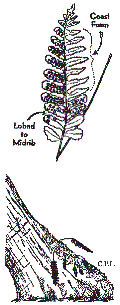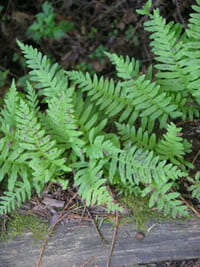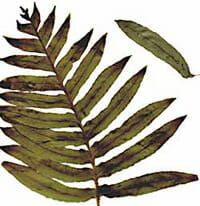Licorice Fern – Polypodiales Polypodiaceae Polypodium glycyrrhiza
 |
 |
 |
Identification & Description:
The long, pointed-trangle fronds of this evergreen fern range in size from 10-70cm on average. Its leathery leaves are once pinnately divided, with a light brown stipe; they are usually shorter than 50cm (20 inches) long. Its rhizome (root-like structure) has a scaly, reddish-brown outer covering, with a sweet, succulent inside that resembles the taste of licorice. Its sori (seed-like sack) of 3mm across or larger, are oval to round and located in a single file row on either side of a main vein on the underside part of the leaf. The sori (sack of spores) lack an indusium (a membrane that covers the sori)
Physical Characteristics
Fern growing to 0.45m by 0.45m . It is hardy to zone 7. We rate it 1 out of 5 for usefulness.
The plant prefers light (sandy), medium (loamy) and heavy (clay) soils. The plant prefers acid, neutral and basic (alkaline) soils. It can grow in semi-shade (light woodland) or no shade. It requires moist soil and can tolerate drought.
Edible Uses
Root.
Root – raw or cooked The root is sweetly liquorice-flavoured but is thin and fibrous and virtually inedible. The root was commonly chewed for its very pleasant flavour by many native North American Indian tribes. It was often used as an appetiser, especially for children who would not eat. Apart from its used as a pleasantly flavoured chew, it was seen as a famine food and was only used when there was a shortage of better foods.
Habitat
Partially shaded forests, sometimes found on mossy logs, from central California to British Columbia. Elevation ranging from sea level to 600 m.
Cultivation details
Tolerates short periods of drought and direct sunlight, but it prefers bright filtered light. Plants can be grown on a drystone wall.
Members of this genus are rarely if ever troubled by browsing deer.
There are several named varieties selected for their ornamental value.
Reproduction:
Ferns reproduce both by seed-like structures called spores and vegetatively. Most ferns have spores on the underside of their leaves. These spores are stored in sacks called sori. When the climate and moisture are right, the fern releases its spores; some are blown through the wind, some travel on animals, and others fall to the ground. Each spore contains only one set of chromosomes (haploid) that are found in the fern cells. Thus, a spore itself cannot grow into a plant, but must undergo a process of growth called “alternate generation”. A spore will grow into a gametophyte plant. A gametophyte is a premature fern that produces separate male and female parts of the plant. The gametophyte tends to be a small (1cm), heartshaped plant with fine hair-like roots called rhizoids. In this stage, the gametophyte produces tiny reproductive structures; the spherical antheridia which holds the sperm and the archegonia, which holds a single egg. The sperm swims in the water on the prothallus and finds a archegonia, which it fertilizes. The fertilized egg forms a zygote from which a new plant grows. The plant incubates inside the prothallus for a short period of time until it is developed enough to sink its roots into the soil and grow